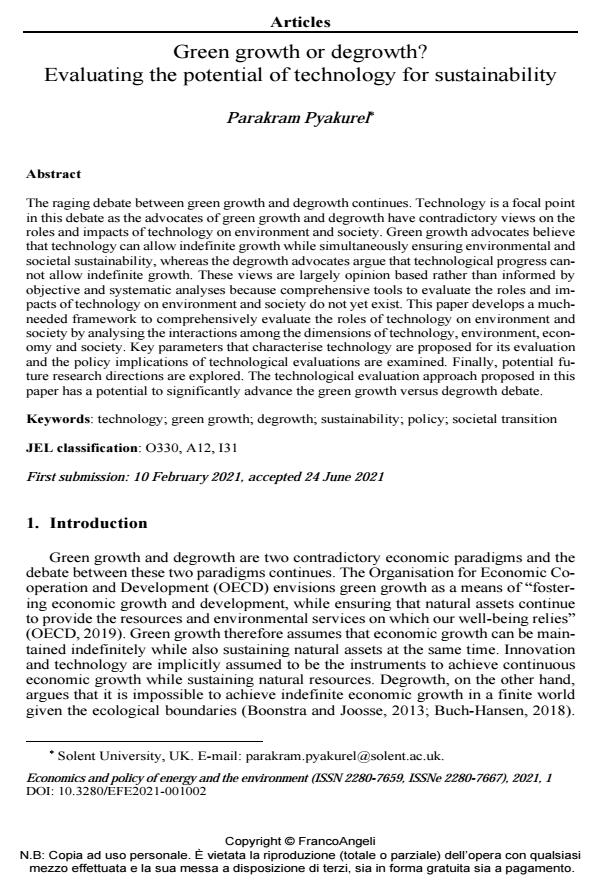Green growth or degrowth? Evaluating the potential of technology for sustainability
Titolo Rivista ECONOMICS AND POLICY OF ENERGY AND THE ENVIRONMENT
Autori/Curatori Parakram Pyakurel
Anno di pubblicazione 2021 Fascicolo 2021/1
Lingua Inglese Numero pagine 16 P. 21-36 Dimensione file 267 KB
DOI 10.3280/EFE2021-001002
Il DOI è il codice a barre della proprietà intellettuale: per saperne di più
clicca qui
Qui sotto puoi vedere in anteprima la prima pagina di questo articolo.
Se questo articolo ti interessa, lo puoi acquistare (e scaricare in formato pdf) seguendo le facili indicazioni per acquistare il download credit. Acquista Download Credits per scaricare questo Articolo in formato PDF

FrancoAngeli è membro della Publishers International Linking Association, Inc (PILA)associazione indipendente e non profit per facilitare (attraverso i servizi tecnologici implementati da CrossRef.org) l’accesso degli studiosi ai contenuti digitali nelle pubblicazioni professionali e scientifiche
The raging debate between green growth and degrowth continues. Technology is a focal point in this debate as the advocates of green growth and degrowth have contradictory views on the roles and impacts of technology on environment and society. Green growth advocates believe that technology can allow indefinite growth while simultaneously ensuring environmental and societal sustainability, whereas the degrowth advocates argue that technological progress cannot allow indefinite growth. These views are largely opinion based rather than informed by objective and systematic analyses because comprehensive tools to evaluate the roles and impacts of technology on environment and society do not yet exist. This paper develops a much-needed framework to comprehensively evaluate the roles of technology on environment and society by analysing the interactions among the dimensions of technology, environment, economy and society. Key parameters that characterise technology are proposed for its evaluation and the policy implications of technological evaluations are examined. Finally, potential future research directions are explored. The technological evaluation approach proposed in this paper has a potential to significantly advance the green growth versus degrowth debate.
Parole chiave:technology; green growth; degrowth; sustainability; policy; societal transition
Jel codes:O330, A12, I31
- Degrowth and Public Choice: Navigating Private Interests and Power Dynamics for a Sustainable Future Sule Gunduz - Ozgur, in Current Research in Social Sciences /2025 pp.51
DOI: 10.30613/curesosc.1578157 - Economic Growth and Sustainability: Debating the Pros and Cons of Degrowth and Green Growth Zeynep Asli Alici, in SSRN Electronic Journal /2023
DOI: 10.2139/ssrn.4663215 - [Retracted] Investigating the Impact of Transportation Infrastructure and Tourism on Carbon Dioxide Emissions in China Qiang Zhang, Muhammad Tayyab Sohail, in Journal of Environmental and Public Health 8421756/2022
DOI: 10.1155/2022/8421756 - The Impact of Environmental Technology and Environmental Policy Strictness on China’s Green Growth and Analysis of Development Methods Yiming Wu, Yichao Zhang, Muhammad Tayyab Sohail, in Journal of Environmental and Public Health 1052824/2022
DOI: 10.1155/2022/1052824
Parakram Pyakurel, Green growth or degrowth? Evaluating the potential of technology for sustainability in "ECONOMICS AND POLICY OF ENERGY AND THE ENVIRONMENT" 1/2021, pp 21-36, DOI: 10.3280/EFE2021-001002